Things to do in Hanoi
The bustling nature of this city seamlessly synchronises with its old-world feel. This combination is the reason it is so attractive to backpackers and luxury holidaymakers alike. As if this wasn't enough, its rich history has been steeped in a mythic aura due to its relatively recent introduction to the tourist landscape.
Hanoi is as much a romantically charming city as Ho Chi Minh City is a hive of commercial interest and big-city living. Its lively merchant quarters and bar districts host tourists until first light, where cheap accommodation and drinks make the fun that much more enjoyable. During the day, museums, temples, memorials and the famous Old Quarter of Hanoi provide a myriad of cultural experiences unique to the city.
Within Hanoi's busy streets lie some of Vietnam's most tranquil cloisters and sanctuaries, tucked away from the daily flurry.
If the city lights become too bright, Sapa and Bac Ha are two nearby country getaways that offer an opportunity to experience rural Vietnam. In addition, no trip to Hanoi would be complete without a foray into Halong Bay, often accompanied by a stay at Cat Ba Island. These emerald waters are famous for their adventure activities, set in a bay littered with thousands of small islands and inlets, which are the product of a giant dragon who stormed through the bay aeons ago, according to legend.
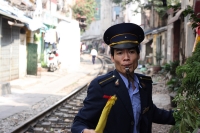
Old Quarter
The ancient meandering streets of the Old Quarter are each named after the crafts and speciality trades traditionally practised by the original artisan's guilds in the 13th century…
Old Quarter
The ancient meandering streets of the Old Quarter are each named after the crafts and speciality trades traditionally practised by the original artisan's guilds in the 13th century. Each guild was grouped around a temple, or dinh, dedicated to the particular beliefs of the village from where the guild originated, and many of these temples are open to the public today. The early merchant's quarter affords an intriguing glimpse into life centuries ago with covered markets, and the ancient narrow buildings that still line the streets, known as tube or tunnel houses that contained shops. Businesses were taxed according to the width of their storefront and resulted in shops only seven foot (2m) wide with a series of storerooms, workshops and living quarters extending behind to a length of up to 197ft (60m). Many streets are still devoted to a predominant trade such as silks, religious objects or textiles, silver jewellery, antiques, and there are numerous art galleries and craft stores, as well as cafes and pavement restaurants lining the streets. Traffic within the Old Quarter is a chaotic mix of bicycles, motorbikes and pedestrians passing noisily down the narrow streets and shady alleyways.
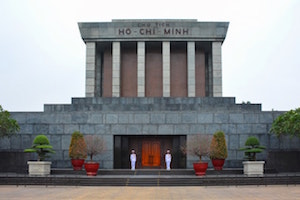
Ho Chi Minh’s Mausoleum
Ba Dinh Square was where Ho Chi Minh read out the Declaration of Independence in 1945, and is the site of annual national celebrations today. The Ho Chi Minh Mausoleum dominates th…
Ho Chi Minh’s Mausoleum
Ba Dinh Square was where Ho Chi Minh read out the Declaration of Independence in 1945, and is the site of annual national celebrations today. The Ho Chi Minh Mausoleum dominates the site's west side and is where the embalmed body of the beloved public figure, 'father of the modern state', and 'liberator of the Vietnamese people' is displayed. The body of Ho Chi Minh is enclosed in a glass case, the traditional way to honour famous communist leaders. Security is tight, there is a strict dress code and it is imperative to maintain a respectful demeanour while inside; this also means no photographs. Nearby is the Ho Chi Minh Museum that commemorates his life, housing a collection of military orders, correspondence, manifestos and photographs that illustrates the crucial role he had in the country's history.
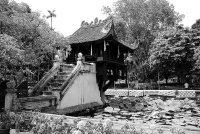
One Pillar Pagoda
One Pillar Pagoda was constructed to celebrate the tale of the heirless Emperor Ly Thai Tong, who dreamt about receiving a son from the Buddhist goddess of mercy and compassion, se…
One Pillar Pagoda
One Pillar Pagoda was constructed to celebrate the tale of the heirless Emperor Ly Thai Tong, who dreamt about receiving a son from the Buddhist goddess of mercy and compassion, seated on a lotus flower. He married shortly after and had a son, and the pagoda was built to honour the event. It is the most interesting of the city's numerous pagodas and, beneath the ornate curved roof, people come to pray for fertility and well-being, with allegedly miraculous effects. The unique wooden structure was designed to resemble a lotus flower, the Buddhist representation of enlightenment, emerging out of the water, with the single stone pillar its symbolic stalk. It was destroyed by the French during the first Indochina War and was subsequently rebuilt.
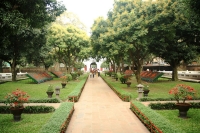
Temple of Literature (Van Mieu)
The Temple of Literature is Vietnam's historical seat of learning and is the most sacred place for the disciples of Confucius. It is one of the few remaining buildings from the ori…
Temple of Literature (Van Mieu)
The Temple of Literature is Vietnam's historical seat of learning and is the most sacred place for the disciples of Confucius. It is one of the few remaining buildings from the original city founded by Emperor Ly Thanh Tong in the 11th century and is a well-preserved example of Vietnamese architecture. It became the site of the country's first university in 1076. Consisting of a complex of small buildings and five walled courtyards, it was an exclusive establishment teaching the principles of Confucius. In the third courtyard is a pond, the Well of Heavenly Clarity, and beside it are 82 stone stelae, mounted on tortoises and engraved with the names of successful graduates. Over a period of 900 years, thousands of Vietnamese scholars graduated from the university. In honour of their teacher's legacy, there is also a temple dedicated to Confucius, a place where the king and his mandarins would make sacrifices.
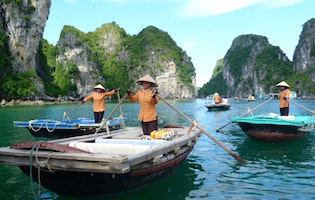
Halong Bay
The natural wonder of Halong Bay has been declared a UNESCO World Heritage Site. Renowned for its spectacular scenery and limestone grottos and caves, the bay is peppered with over…
Halong Bay
The natural wonder of Halong Bay has been declared a UNESCO World Heritage Site. Renowned for its spectacular scenery and limestone grottos and caves, the bay is peppered with over 1,600 inlets and tiny islands emerging almost mystically out of the emerald waters of the Gulf of Tonkin. Wind and wave erosion have scored the site to form dramatic rock shapes, many of which contain caves. Many of the islands have been named for their astonishing resemblance to their namesakes, such as Dragon, Incense Burner, Pair of Roosters and Man's Head Islands. The weird protuberances have been at the source of several local legends, particularly about a dragon whose thrashing tail created the bay and its islands. The name Vinh Ha Long means 'where the dragon descended into the sea'. The most impressive cave is the Hang Dau Go (Grotto of the Wooden Stakes), an extensive grotto with rock formations presenting various eerie images in the mysterious light. It was named from the Battle of 1288 when General Tran Hung Dao prepared hundreds of stakes to be planted in the riverbed of the largest chamber to counter a boat attack. Nearby the beautiful Hang Thien Cung cave is famous for its sparkling stalagmites and stalactites. When booking a cruise in advance, travellers should consider reserving a night or two, to experience Halong Bay at its most picturesque; sunrise, sunset and star-scattered night.
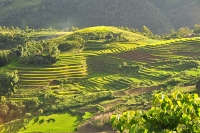
Sapa and Bac Ha
The old hill station of Sapa sits high on the edge of a plateau surrounded by spectacular scenery and the Hoang Lien Mountains, which boast Vietnam's highest peak, Fan Si Pan. Sapa…
Sapa and Bac Ha
The old hill station of Sapa sits high on the edge of a plateau surrounded by spectacular scenery and the Hoang Lien Mountains, which boast Vietnam's highest peak, Fan Si Pan. Sapa functions as a market town and a gathering spot for local tribes who come into town to trade every weekend. The market is excellent for buying handicrafts and people watching. Colourful tunics of the Dao and Giay people mix with the black and blue clothing and silver ornamentation of the Black Hmong tribe, while bright red scarves cover the heads of the Red Hmong who carry large woven baskets on their backs brimming with goods. Nearly 75 miles (140 km) from Sapa is the small town of Bac Ha. Situated in a valley, Bac Ha is famous for its Sunday market. Much less touristy than Sapa, the market is a riot of colour and noise, a place not only for trade but also for socialising. All paths leading into town are filled with people going to market, some riding horses or water buffalo, and the square is a mix of different minorities, buying and selling, or gathered in groups around a central pot of food. The Flower Hmong are the most vivid, with richly coloured clothes of bright red, blue and pink, and skirts embroidered with delicate flowers. The markets have become a major tourist attraction and it is important that visitors to the region are sensitive to local culture and traditions, particularly when taking photographs of people.
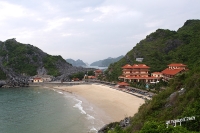
Cat Ba island
For most, a trip in Halong Bay means at least a night on Cat Ba Island. Many enlist for a package tour of one night on the island and one on a boat, but Cat Ba is worth investing e…
Cat Ba island
For most, a trip in Halong Bay means at least a night on Cat Ba Island. Many enlist for a package tour of one night on the island and one on a boat, but Cat Ba is worth investing extra time in. This 54 sq mile (140 sq km) island offers impressive beach relaxation, and hardcore outdoor activities include kayaking, trekking and world-class rock climbing. Travellers who wish to relax can choose between three beaches that are within walking distance of town. Each is spacious and all are protected inlets with views of Halong islands. Beaches one and three are the most secluded and offer beautiful views from the short walks along surrounding cliff lines. Those looking for something more rugged can visit the many limestone cliffs dotting the island, as they're ideal for rock climbing; hotels located on the town's main strip offer guides and gear. Various treks range in length but most are fairly steep. However, the reward is well worth it, as they give a bird's-eye-view of the island's national park, which is also home to the rare Cat Ba Langur. All hotels can arrange excellent boat tours of the surrounding islands. These include visits to deep caves with stalagmites and stalactites, secluded swimming holes, floating fish farms and kayaking. The tour is the same regardless of who it's booked through, so the cheaper the better. Whether it has been a relaxing day of sun and sea or one of thrilling adventure, it must end at the bay's floating restaurant, which has some of the best seafood in Vietnam.



